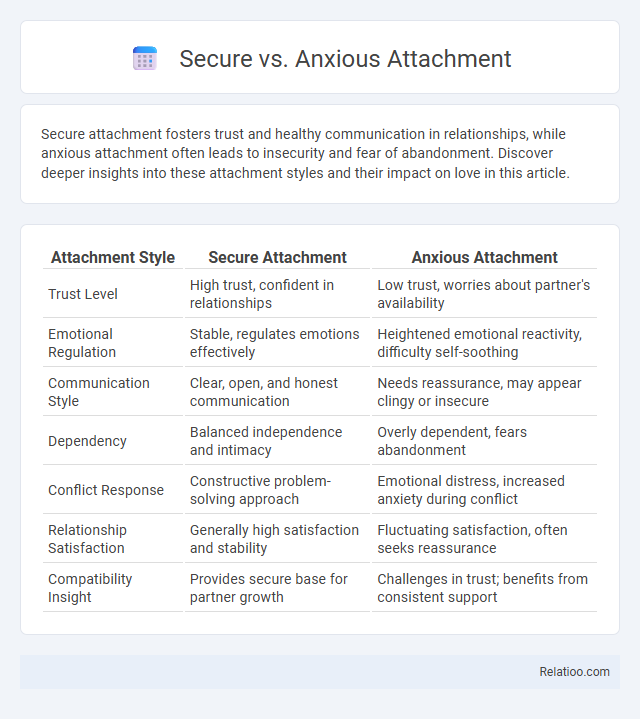Secure attachment fosters trust and healthy communication in relationships, while anxious attachment often leads to insecurity and fear of abandonment. Discover deeper insights into these attachment styles and their impact on love in this article.
Table of Comparison
| Attachment Style | Secure Attachment | Anxious Attachment |
|---|---|---|
| Trust Level | High trust, confident in relationships | Low trust, worries about partner's availability |
| Emotional Regulation | Stable, regulates emotions effectively | Heightened emotional reactivity, difficulty self-soothing |
| Communication Style | Clear, open, and honest communication | Needs reassurance, may appear clingy or insecure |
| Dependency | Balanced independence and intimacy | Overly dependent, fears abandonment |
| Conflict Response | Constructive problem-solving approach | Emotional distress, increased anxiety during conflict |
| Relationship Satisfaction | Generally high satisfaction and stability | Fluctuating satisfaction, often seeks reassurance |
| Compatibility Insight | Provides secure base for partner growth | Challenges in trust; benefits from consistent support |
Understanding Attachment: Secure vs Anxious
Understanding attachment styles reveals key differences between secure and anxious types, influencing emotional needs and relationship dynamics. Secure attachment is characterized by confidence in emotional availability and effective communication, fostering trust and stability. Anxious attachment involves heightened sensitivity to rejection and fear of abandonment, driving intense emotional needs and patterns of seeking reassurance.
Key Traits of Secure Attachment
Secure attachment is characterized by trust, emotional responsiveness, and comfort with intimacy, enabling you to form healthy, stable relationships. Key traits include effective communication, balanced independence and dependence, and resilience in managing emotional needs. Unlike anxious attachment marked by insecurity and emotional volatility, secure attachment supports consistent emotional availability and mutual support.
Defining Anxious Attachment Styles
Anxious attachment style is characterized by a deep fear of abandonment and a persistent need for validation and reassurance from partners, often stemming from inconsistent caregiving in early childhood. Individuals with this attachment style exhibit heightened emotional sensitivity and a strong desire for closeness, which can lead to clinginess and difficulty trusting others. Understanding anxious attachment is essential for addressing emotional needs and fostering healthier, more secure relationships.
Childhood Origins of Attachment Patterns
Childhood experiences with primary caregivers fundamentally shape secure and anxious attachment patterns, influencing emotional needs throughout life. Secure attachment emerges from consistent, responsive caregiving, fostering confidence and healthy emotional regulation. In contrast, inconsistent or neglectful caregiving contributes to anxious attachment, characterized by heightened emotional needs and fear of abandonment.
Emotional Impact of Secure vs Anxious Attachment
Secure attachment fosters emotional stability by providing consistent support, enabling You to regulate stress and build trust. Anxious attachment creates heightened emotional sensitivity, often leading to fear of abandonment and difficulty managing negative feelings. The emotional impact highlights how secure attachment promotes resilience, whereas anxious attachment triggers vulnerability and emotional instability.
Relationship Dynamics: Secure vs Anxious
Secure attachment supports healthy relationship dynamics by fostering trust, open communication, and emotional stability, enabling partners to effectively meet each other's emotional needs. Anxious attachment often leads to heightened dependency, fear of abandonment, and difficulty regulating emotions, which can create tension and insecurity in relationships. Understanding these attachment styles helps identify patterns that influence emotional responsiveness and relational satisfaction.
Communication Differences in Attachment Styles
Secure attachment fosters open and clear communication, allowing you to express your emotional needs confidently and receive support without fear of judgment. Anxious attachment, in contrast, often leads to heightened worry over rejection, causing communication to become intense, overly frequent, or emotionally charged as a way to seek reassurance. Understanding these communication differences helps improve relational dynamics by tailoring responses to each attachment style's unique emotional needs.
Attachment Styles and Conflict Resolution
Secure attachment enhances conflict resolution by promoting trust and open communication, allowing you to express your emotional needs clearly and calmly. Anxious attachment styles often lead to heightened sensitivity and fear of rejection, resulting in conflicts fueled by misinterpretations and emotional volatility. Understanding your attachment style helps manage emotional needs effectively, fostering healthier interactions and reducing misunderstandings during disagreements.
Healing and Shifting Anxious Attachment
Healing anxious attachment involves recognizing patterns of insecurity and unmet emotional needs rooted in early relationships, fostering self-awareness and emotional regulation. Therapeutic interventions like cognitive-behavioral therapy and attachment-based therapy promote shifting toward secure attachment by enhancing trust, communication, and self-soothing skills. Building secure attachment supports emotional resilience, healthier relationships, and fulfillment of essential emotional needs such as safety, validation, and connection.
Building Healthy Relationships with Secure Attachment
Building healthy relationships with secure attachment involves recognizing and meeting your emotional needs through trust, effective communication, and consistent support. Unlike anxious attachment, which often triggers fear of abandonment and insecurity, secure attachment fosters emotional stability and mutual understanding. Prioritizing secure attachment helps you develop deeper connections, resilience, and a balanced approach to intimacy.

Infographic: Secure vs Anxious attachment
 relatioo.com
relatioo.com